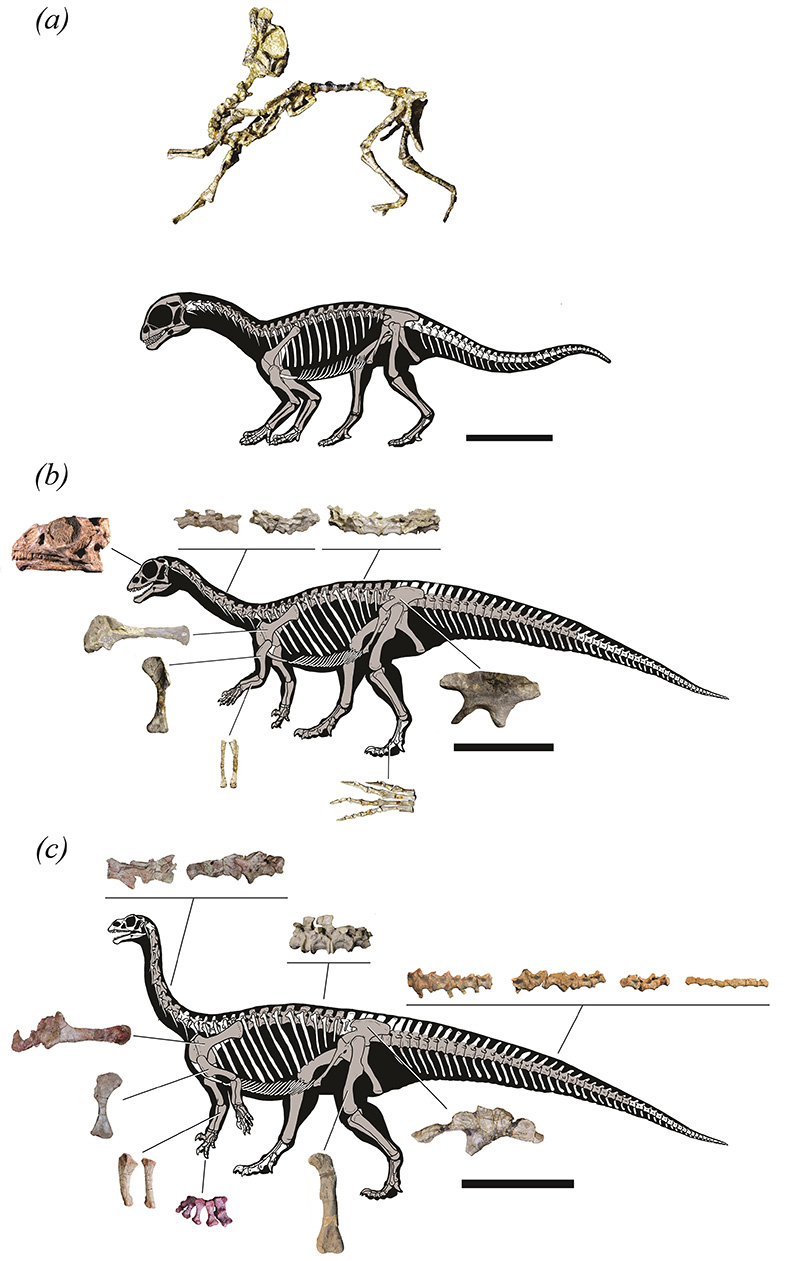Early Jurassic dinosaur shifted from four legs to two legs as it grew up
Scientists have discovered that an early species of dinosaur, Mussaurus patagonicus, could only move on four limbs once born but switched to two legs as it grew up, just as humans do.
As Mussaurus patagonicus existed in the Early Jurassic period, just over 200 million years ago, this ground-breaking study provides an interesting insight into the evolution of later dinosaurs.

Mussaurus lived in what is now Patagonia, Argentina. At birth, the dinosaur was just the size of a human palm, but in just eight years, when it reached adulthood, grew to weigh over a tonne. It might have barely been able to walk or run on two legs at the age of one, but would have only committed to being bipedal once it reached adulthood.
The study, which was published today in Scientific Reports, was conducted by an international team of researchers based at Argentina’s Museo de La Plata and National Scientific and Technical Research Council (CONICET), and at the Royal Veterinary College (RVC), United Kingdom. The team scanned key fossils of Mussaurus into 3D models, connected the bones into digital skeletons, and added soft tissue to estimate the shape of the body and its major segments such as head, neck, torso, tail and limbs.
They were then able to use these computer models to estimate the whereabouts of the body’s centre of mass; the point at which all weight can be assumed to act through. This estimate enabled them to then test whether different models of different growth stages of Mussaurus could have stood on two legs or not, because the centre of mass must be placed under the feet in such poses.
Carrying out this research has given the academics greater knowledge of why later multi-tonne giant sauropods, dinosaurs such as Diplodocus and Brachiosaurus notable for their enormous size, remained on four limbs throughout their lives, as well. In a future study, the scientists plan to use the computer models to simulate in greater detail how Mussaurus may have actually moved, such as how fast it could walk or run.
The research was funded by the International Exchanges Program of the Royal Society, the European Union’s Horizon 2020 research and innovation program via a grant to Professor John Hutchinson (RVC), Agencia Nacional de Promoción Científica y Tecnológica and CONICET.
Co-first author Dr Alejandro Otero, researcher at CONICET in Argentina, commented: “Mussaurus switched from four legs as a baby to two legs by adulthood, much as humans do. It is important to notice that such locomotor switching is rare in nature and the fact that we were able to recognize it in extinct forms like dinosaurs highlights the importance of our exciting findings.”
Co-first author Dr Andrew Cuff, postdoctoral researcher at the RVC, commented: “Mussaurus underwent an exceptional growth sequence. They hatched at a mass similar to baby chickens, but in the next eight years became as heavy as a rhinoceros, all whilst changing from walking on four legs to walking on two. It is only by using digital modelling that we have been able to gain these new insights into these long-extinct animals.”
Dr John Hutchinson, Professor of Evolutionary Biomechanics at the RVC, commented: “We created the first 3D representation of the major changes of body form and function across the growth of a dinosaur. And we were surprised to learn that enlargement of the tail and reduction of the neck had more of an effect on how Mussaurus stood than how long its forelimbs were, which is what people used to think.”

Notes to Editors
For more information please contact:
- Alex Cassells (alexander.cassells@plmr.co.uk) or Ploy Radford (ploy.radford@plmr.co.uk)
- Press Line: 0800 368 9520
About the RVC
- The Royal Veterinary College (RVC) is the UK's largest and longest established independent veterinary school and is a constituent College of the University of London.
- The RVC is ranked as the world’s number one veterinary school in the QS World University Rankings 2019.
- The RVC offers undergraduate, postgraduate and CPD programmes in veterinary medicine, veterinary nursing and biological sciences.
- The RVC was the first veterinary school in the world to hold full accreditation from AVMA, EAEVE, RCVS and AVBC, and currently holds full accreditation from RCVS, AVBC and AVMA and conditional from EAEVE.
- In 2017, the RVC received a Gold award from the Teaching Excellence Framework (TEF) – the highest rating a university can receive.
- A research-led institution, the RVC maintained its position as the top veterinary institution in the Research Excellence Framework (2014), with 79% of its submission being rated as world-class or internationally excellent.
- The RVC also provides animal owners and the veterinary profession with access to expert veterinary care and advice through its teaching hospitals: the Beaumont Sainsbury Animal Hospital, in central London, and the Queen Mother Hospital for Animals (Europe's largest small animal referral centre) and Equine Referral Hospital, both located at the Hertfordshire campus.

